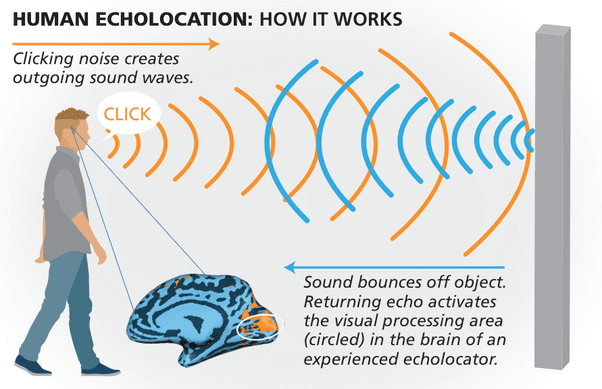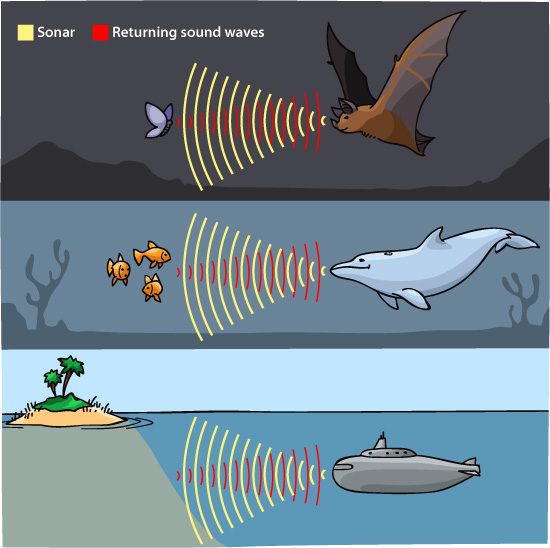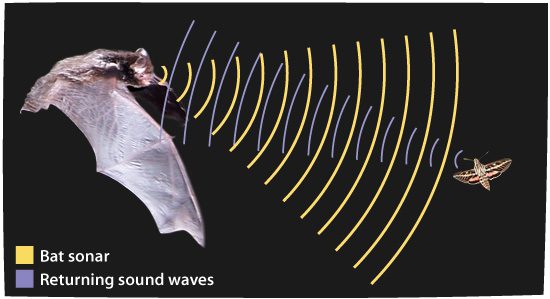Intro Of Echolocation
Hello readers, my name is Md. Saiful Islam and I’m a paramedic. Today I’m here to taking you –What is Echolocation?
When it comes to getting around, pretty much all animals rely on sight to figure out what’s around them. Where their next meal is, and what obstacles might be in their path.
Light from luminous sources like the sun bounces off the objects around us. And some of it enters our eyes, allowing us to see.

But what happens when there’s not enough light to see by? A few animals have evolved a versatile technique that uses SOUND. Rather than light, to build a picture of their surroundings.
The technique is called echolocation. And it’s the source of success for animals in the air, on the ground, and under water.
But how does it work?
How does echolocation work
Some of the most famous echolocators are bats. The saying ‘blind as a bat’ is a bit of a misnomer, because bats have perfectly good eyesight. But their twenty-twenty vision doesn’t do them much good when it comes to hunting in the dark.
Instead, they let out a series of very high pitched clicks or squeaks. These are so high-pitched that they’re beyond the range of human hearing, which is known as ultrasound.

Learn more about laboratory equipment.
How sound bounces
Now, sound travels as a compression wave through the air, like this. And just like light, when the sound waves hit an object, in this case it’s my hand, it bounces back.
And it’s that bounce-back that we know as an echo. Bats and other echolocators are specially tuned to the properties of the echoes to get a good idea of their surroundings.
Special muscles in the bat’s throat allow them to make ultrasound clicks up to one hundred and ninety times every second.
And their ears are specialized with folds that makes them super-sensitive of the direction of any sounds around them. The speed that an echo returns to them tells them the distance to the nearest object. If it comes back quickly, the object is closer, because the sound hasn’t had to travel as far.
The intensity of the returning sound also gives an indication of the size of the object.
If it is small, some of the sound waves will go past either side. And the returning echo will be just a whisper. If the right ear receives the echo before the left ear. The bat can know that the object is to the right of them, and vice versa.

Echolocating Animals
Bats,
Bats can even figure out the direction. That an insect is moving from the change in pitch of the returning echo. If it’s moving towards them, the sound waves get squashed up and become higher in pitch. If it’s moving away, the returning echo will be lower pitched. This is known as the Doppler effect, which we experience when an ambulance sounding its sirens speeds past us.
Putting all of this together means a bat can figure out the size, location, proximity. And motion of their prey with pinpoint accuracy. Processing the information from the echoes automatically like we process the information from our eyes.
But, while bats may be the master of the dark skies, the waters belong to the odontocete
– that’s toothed whales like dolphins, sperm whales and orcas. This group of marine mammals have also harnessed the power of echolocation to navigate. And hunt in deep, dark, or murky waters. Sound actually travels more than four times faster in water than in air. Making underwater echolocation a fast paced and deadly affair.
Dolphins
Dolphins let out ultrasonic clicks by pushing air through their nasal passage. These last just a hundred microseconds, that’s a ten thousandth of a second. But can help them locate objects as small as a can of tuna. From a distance equivalent to the length of two football pitches.
Whales
The sperm whale also owes its successes, as well as its massive head to echolocation. The bulk of its head is filled with a special waxy substance called spermaceti. The whale generates sounds at the front of the head. And the sound waves travel back into the head to be reflected off a plate on their skull. That’s shaped like a satellite dish. This focuses the sound waves into a narrow, powerful beam for more accurate pointing.
Some male sperm whales can produce audible clicks that are as loud as 230 decibels. Much louder than a jet plane. Which help them to hunt at depths of more than a kilometer, far beyond the reach of sunlight.
While these animals have evolved to be masters of their art. The wonders of seeing with sound aren’t beyond the reach of humans either. Daniel here is blind, but has taught himself to echolocate. And it’s been helping him to get around independently for over forty years.
He clicks his tongue against the roof of his mouth. And listens for the echoes coming back, then just like the animal echolocators. He’s able to form a picture in his mind of the landscape around him.

Returning sound Waves
These trees are very high. The trunk is actually fairly uniform, it’s almost like a pole. And it really is a picture. Studies have shown that when blind people echolocate. They’re activating the visual parts of their brain, just as if they were seeing with their eyes. But it’s not only blind people who can benefit from echolocation. The principle has been turned into some pretty useful technology.
Sonar is used by ships to navigate, find fish shoals, and even search for shipwrecks. It works just the same as animal echolocation. As sound waves are sent down into the water, to be reflected off any objects there. The time it takes for the echo to come back tells
you how far away the fish, submarine, or ocean floor is.
And on a smaller scale. Ultrasound scans use exactly the same method to create images of foetuses developing in the womb. Echolocation really is amazing, so why not try it yourself.
Learn more about this topic click the link






You have brought up a very excellent points, regards for the post.
Once I initially commented I clicked the -Notify me when new feedback are added- checkbox and now every time a remark is added I get 4 emails with the same comment. Is there any way you possibly can take away me from that service? Thanks!
Wow! Thank you! I constantly wanted to write on my blog something like that. Can I take a fragment of your post to my website?
Have you ever thought about writing an ebook or guest authoring on other blogs?
I have a blog based upon on the same information you discuss and would
really like to have you share some stories/information. I know my visitors would appreciate your work.
If you’re even remotely interested, feel free to
shoot me an e-mail.
Thanks for sharing. I read many of your blog posts, cool, your blog is very good.
Your point of view caught my eye and was very interesting. Thanks. I have a question for you.
Your article helped me a lot, is there any more related content? Thanks!
What’s Happening i am new to this, I stumbled upon this I’ve found It absolutely helpful and it has aided me out loads. I hope to contribute & help other users like its aided me. Good job.
Your article helped me a lot, is there any more related content? Thanks!
Hi, i think that i saw you visited my weblog thus i came to “return the favor”.I am trying to find things to improve my web site!I suppose its ok to use a few of your ideas!!
I rattling glad to find this web site on bing, just what I was looking for : D besides saved to my bookmarks.
Hi there! This is my 1st comment here so I just wanted to give a quick shout out and tell you I truly enjoy reading your posts. Can you recommend any other blogs/websites/forums that go over the same subjects? Thanks for your time!
Thanks for helping out, good information.
The analysis had the perfect mix of depth and clarity, like a perfectly mixed cocktail that I just can’t get enough of.
Hello. splendid job. I did not anticipate this. This is a excellent story. Thanks!
I appreciate you sharing this article post.Really thank you! Awesome.
I have read a few just right stuff here. Definitely price bookmarking for revisiting. I wonder how a lot attempt you place to create the sort of magnificent informative site.
naturally like your website however you have to check the spelling on several of your posts. A number of them are rife with spelling issues and I in finding it very troublesome to inform the truth nevertheless I will surely come again again.
I visited a lot of website but I think this one has something special in it in it
I have been browsing on-line greater than three hours as of late, but I never found any attention-grabbing article like yours. It is pretty worth enough for me. In my view, if all site owners and bloggers made just right content material as you did, the web will probably be much more helpful than ever before.
The unique perspective on this subject was enlightening. It’s refreshing to see someone so passionate about their topic.
The work is truly inspirational. I appreciate the depth you bring to The topics.
I’m genuinely impressed by the depth of The analysis. Great work!
Can you be more specific about the content of your article? After reading it, I still have some doubts. Hope you can help me.